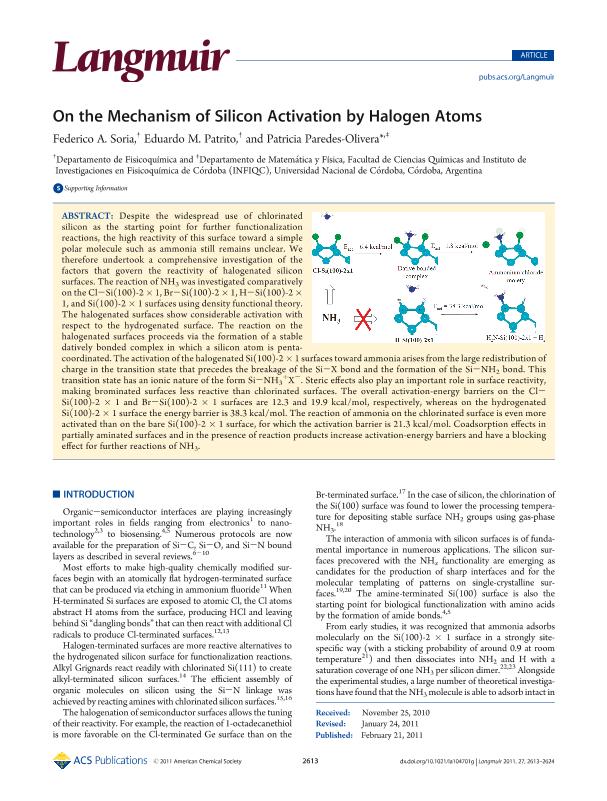Mostrar el registro sencillo del ítem
dc.contributor.author
Soria, Federico Ariel

dc.contributor.author
Patrito, Eduardo Martin

dc.contributor.author
Paredes Olivera, Patricia

dc.date.available
2018-10-04T21:09:16Z
dc.date.issued
2011-03
dc.identifier.citation
Soria, Federico Ariel; Patrito, Eduardo Martin; Paredes Olivera, Patricia; On the mechanism of silicon activation by halogen atoms; American Chemical Society; Langmuir; 27; 6; 3-2011; 2613-2624
dc.identifier.issn
0743-7463
dc.identifier.uri
http://hdl.handle.net/11336/61732
dc.description.abstract
Despite the widespread use of chlorinated silicon as the starting point for further functionalization reactions, the high reactivity of this surface toward a simple polar molecule such as ammonia still remains unclear. We therefore undertook a comprehensive investigation of the factors that govern the reactivity of halogenated silicon surfaces. The reaction of NH3 was investigated comparatively on the Cl-Si(100)-2 × 1, Br-Si(100)-2 × 1, H-Si(100)-2 × 1, and Si(100)-2 × 1 surfaces using density functional theory. The halogenated surfaces show considerable activation with respect to the hydrogenated surface. The reaction on the halogenated surfaces proceeds via the formation of a stable datively bonded complex in which a silicon atom is pentacoordinated. The activation of the halogenated Si(100)-2 × 1 surfaces toward ammonia arises from the large redistribution of charge in the transition state that precedes the breakage of the Si-X bond and the formation of the Si-NH2 bond. This transition state has an ionic nature of the form Si-NH3 +X-. Steric effects also play an important role in surface reactivity, making brominated surfaces less reactive than chlorinated surfaces. The overall activation-energy barriers on the Cl-Si(100)-2 × 1 and Br-Si(100)-2 × 1 surfaces are 12.3 and 19.9 kcal/mol, respectively, whereas on the hydrogenated Si(100)-2 × 1 surface the energy barrier is 38.3 kcal/mol. The reaction of ammonia on the chlorinated surface is even more activated than on the bare Si(100)-2 × 1 surface, for which the activation barrier is 21.3 kcal/mol. Coadsorption effects in partially aminated surfaces and in the presence of reaction products increase activation-energy barriers and have a blocking effect for further reactions of NH3. © 2011 American Chemical Society.
dc.format
application/pdf
dc.language.iso
eng
dc.publisher
American Chemical Society

dc.rights
info:eu-repo/semantics/openAccess
dc.rights.uri
https://creativecommons.org/licenses/by-nc-sa/2.5/ar/
dc.subject
Superficies
dc.subject
Reacciones Superficiales
dc.subject
Si(100)
dc.subject
Dft
dc.subject.classification
Otras Ciencias Químicas

dc.subject.classification
Ciencias Químicas

dc.subject.classification
CIENCIAS NATURALES Y EXACTAS

dc.title
On the mechanism of silicon activation by halogen atoms
dc.type
info:eu-repo/semantics/article
dc.type
info:ar-repo/semantics/artículo
dc.type
info:eu-repo/semantics/publishedVersion
dc.date.updated
2018-10-01T15:23:48Z
dc.journal.volume
27
dc.journal.number
6
dc.journal.pagination
2613-2624
dc.journal.pais
Estados Unidos

dc.journal.ciudad
Washington
dc.description.fil
Fil: Soria, Federico Ariel. Consejo Nacional de Investigaciones Científicas y Técnicas. Centro Científico Tecnológico Conicet - Córdoba. Instituto de Investigaciones en Físico-química de Córdoba. Universidad Nacional de Córdoba. Facultad de Ciencias Químicas. Instituto de Investigaciones en Físico-química de Córdoba; Argentina
dc.description.fil
Fil: Patrito, Eduardo Martin. Consejo Nacional de Investigaciones Científicas y Técnicas. Centro Científico Tecnológico Conicet - Córdoba. Instituto de Investigaciones en Físico-química de Córdoba. Universidad Nacional de Córdoba. Facultad de Ciencias Químicas. Instituto de Investigaciones en Físico-química de Córdoba; Argentina
dc.description.fil
Fil: Paredes Olivera, Patricia. Consejo Nacional de Investigaciones Científicas y Técnicas. Centro Científico Tecnológico Conicet - Córdoba. Instituto de Investigaciones en Físico-química de Córdoba. Universidad Nacional de Córdoba. Facultad de Ciencias Químicas. Instituto de Investigaciones en Físico-química de Córdoba; Argentina
dc.journal.title
Langmuir

dc.relation.alternativeid
info:eu-repo/semantics/altIdentifier/doi/https://dx.doi.org/10.1021/la104701g
dc.relation.alternativeid
info:eu-repo/semantics/altIdentifier/url/https://pubs.acs.org/doi/abs/10.1021/la104701g
Archivos asociados
